All of Me was written in 1931 by Seymour Simons and Gerald Marks and has since become a popular jazz standard, especially among gypsy jazz guitar players. The song is suitable for beginners because of its slow harmonic movement (most chords last two bars).
In this lesson, you will analyze the chords of All of Me, learn how to play the melody, and how to improvise a single-note solo over its chord changes.
Recommended listening:
- Louis Armstrong – 1931-1932
- Django Reinhardt – Nuages (1940)
- Billie Holiday – Love Me, Love My Dog (1941)
- Frank Sinatra – Swing Easy! (1954)
- Ella Fitzgerald – Ella Swings Gently with Nelson (1962)
All of Me – Video
All of Me – Melody
Backing Track (made with Band in a Box)
Listen & Play-Along
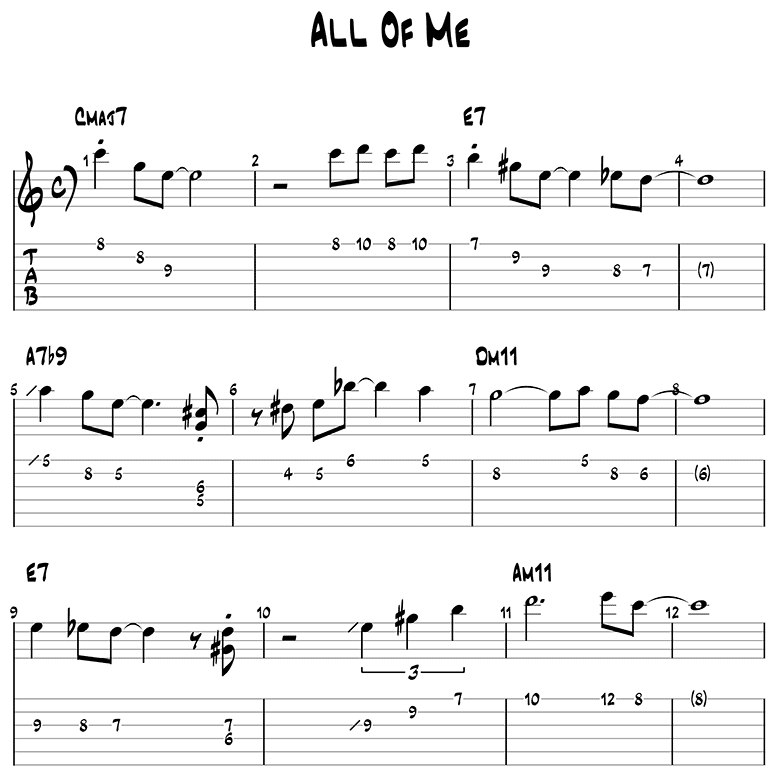
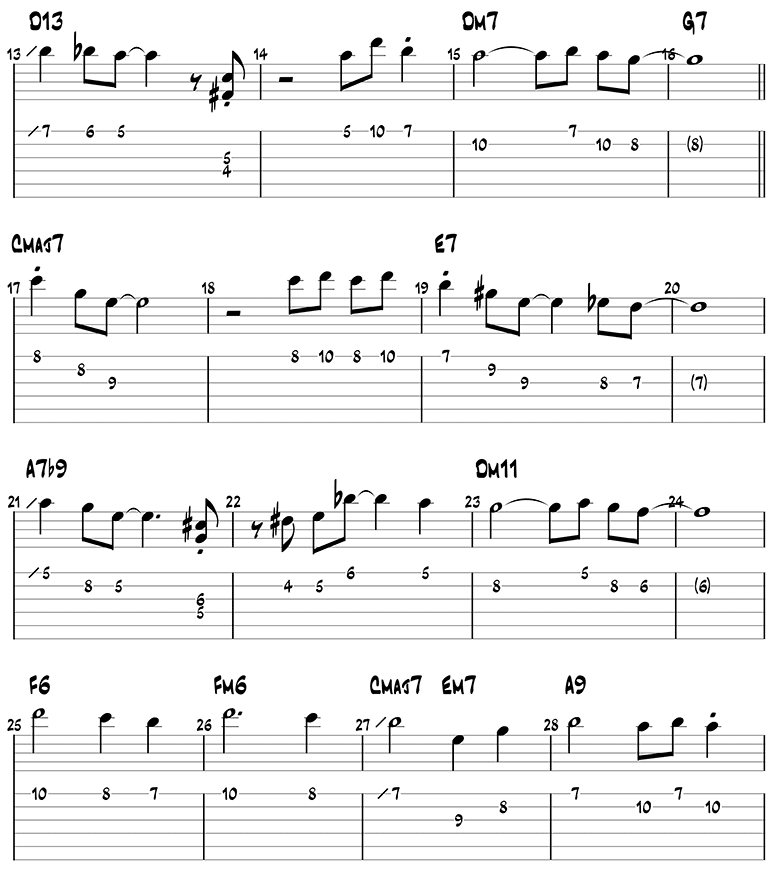

All of Me – Analysis
Before we go on to the solo, we’ll have a look at the harmonic structure and the scales you can use over All of Me.
Structure: 32 bars long, with an ABAC structure. A1 and A2 are identical.
Key: the version in the Real Book is in C major. The original was recorded in Bb major.
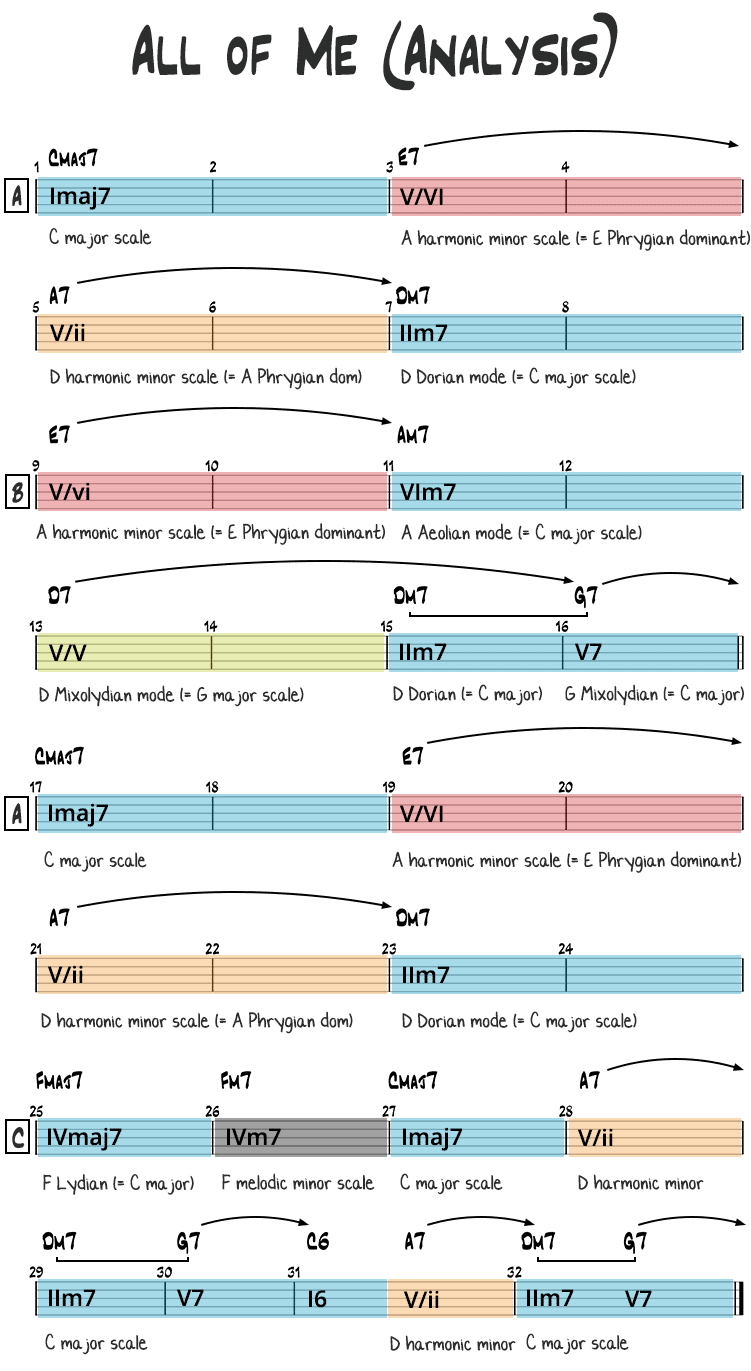
C Major Scale
The C major scale can be used on all chords that are marked blue in the analysis chart.
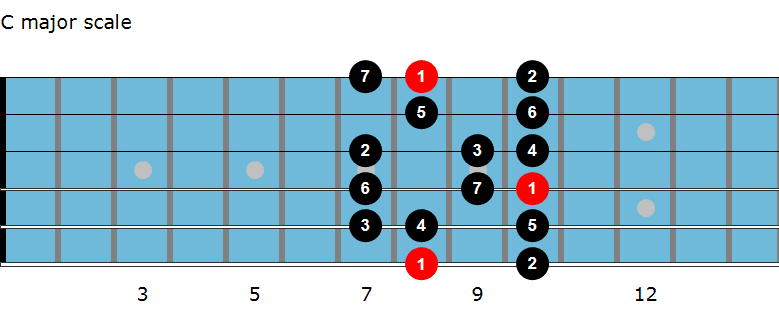
As an alternative to the major scale, I use bebop scales in the solo.
On major chords, you can use the major bebop scale (major scale + b6).
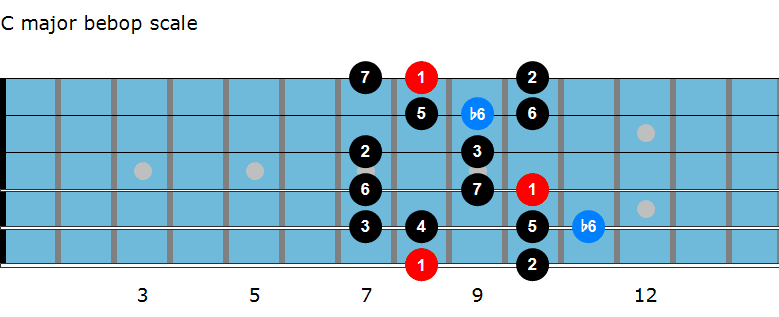
On dominant chords, you can use the dominant bebop scale (Mixolydian mode + 7).
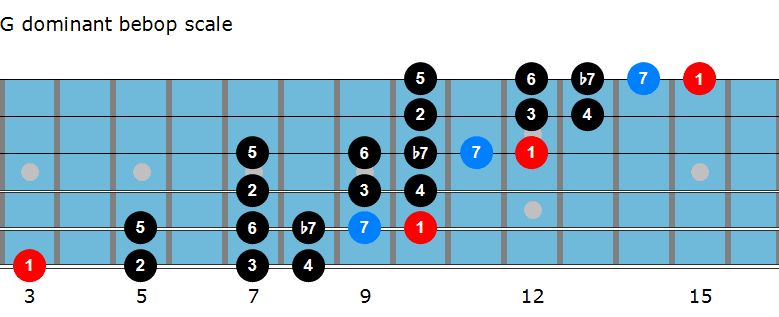
On minor chords, you can use the minor bebop scale (Dorian mode + 7).
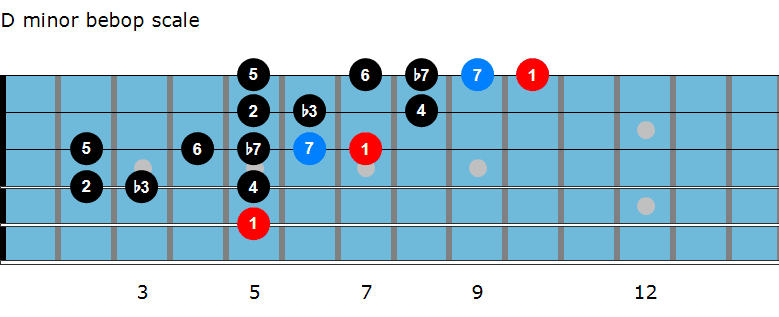
A Harmonic Minor Scale
E7 (in All of Me) is a secondary dominant chord that resolves either to A7 or Am7.
I (Cmaj7) going to V/VI (E7) is a common chord progression and is also used in jazz standards such as Someday my Prince Will Come, After You’ve Gone, Come Rain or Come Shine, I’ll Be Seeing You, Basin Street Blues, I Should Care, and On a Slow Boat to China.
When it resolves to Am7 (bar 9), it is called a secondary dominant and is notated as V/vi (dominant of the vi).
A secondary dominant is a dominant chord that resolves to any chord that is not the tonic (I).
When it resolves to A7 (bar 3), it is called an extended dominant and is notated as V/VI (dominant of the VI).
An extended (secondary) dominant is a dominant chord that resolves to another dominant chord.
The scale of choice to play over E7 is the A harmonic minor scale, also known as the E Phrygian dominant scale or the E Mixolydian b9 b13 scale.
| A harmonic minor scale | A | B | C | D | E | F | G# |
|---|---|---|---|---|---|---|---|
| Played over E7 | 11 | 5 | b13 | b7 | 1 | b9 | 3 |
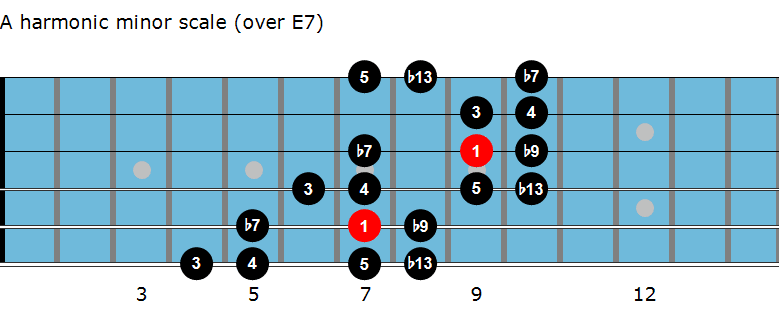
D Harmonic Minor Scale
The A7 (in All of Me) is a secondary dominant that resolves to Dm7 (IIm7).
The scale of choice here is the D harmonic minor scale (= A Phrygian dominant).
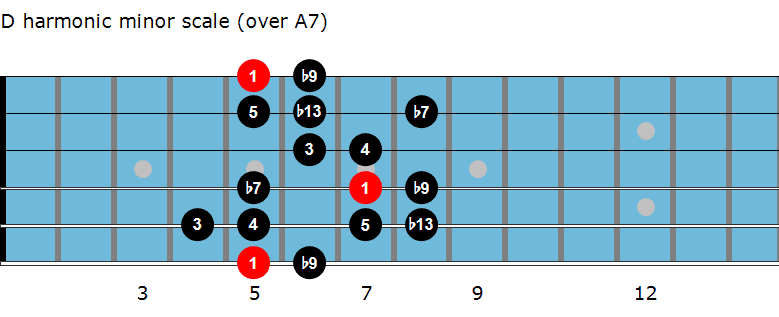
D Mixolydian Mode
D7 in a C major key is “the” secondary dominant (V/V or the “dominant of the dominant”).

It’s a good idea to include this chord progression into your practice routine because it is used in a lot of jazz standards such as Days of Wine and Roses, Don’t Get Around Much Anymore, and Just Friends.
The scale of choice here is the D Mixolydian mode, the 5th mode of the G major scale.
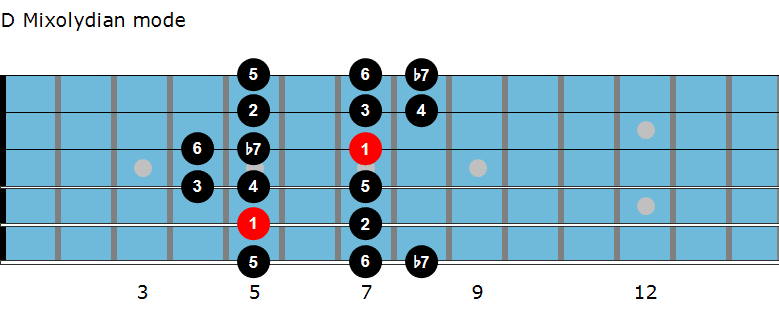
F Melodic Minor Scale
Fm(6) is the IVm in the key of C major and is an example of modal interchange.
This chord is borrowed from the parallel minor of C and is a common occurrence in pop music (it’s a favorite of the Beatles) and jazz music, in standards such as Fly Me to the Moon, How Deep is the Ocean, and How High the Moon.
It is often used between the IV and the I with a chromatic voice leading going from the 3rd (of Fmaj7) to the b3 (of Fm7) to the 5th (of Cmaj7).
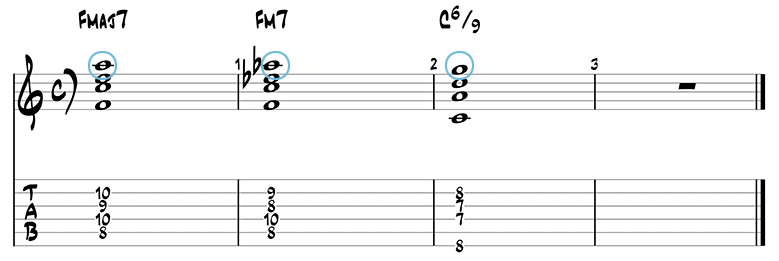
The scale of choice to play over Fm7 (as a IVm) is the F melodic minor scale.
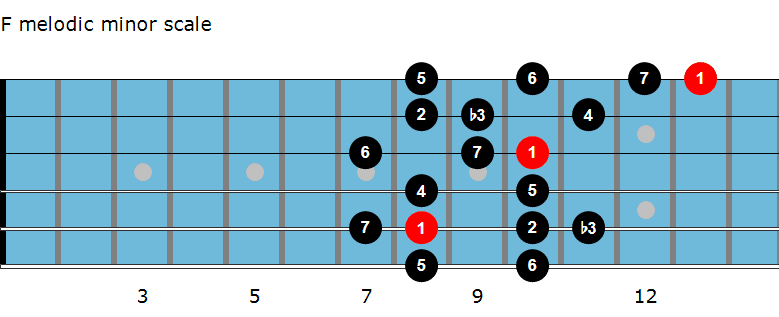
All of Me – Solo
In this basic solo, I focus on arpeggios and the bebop scales.
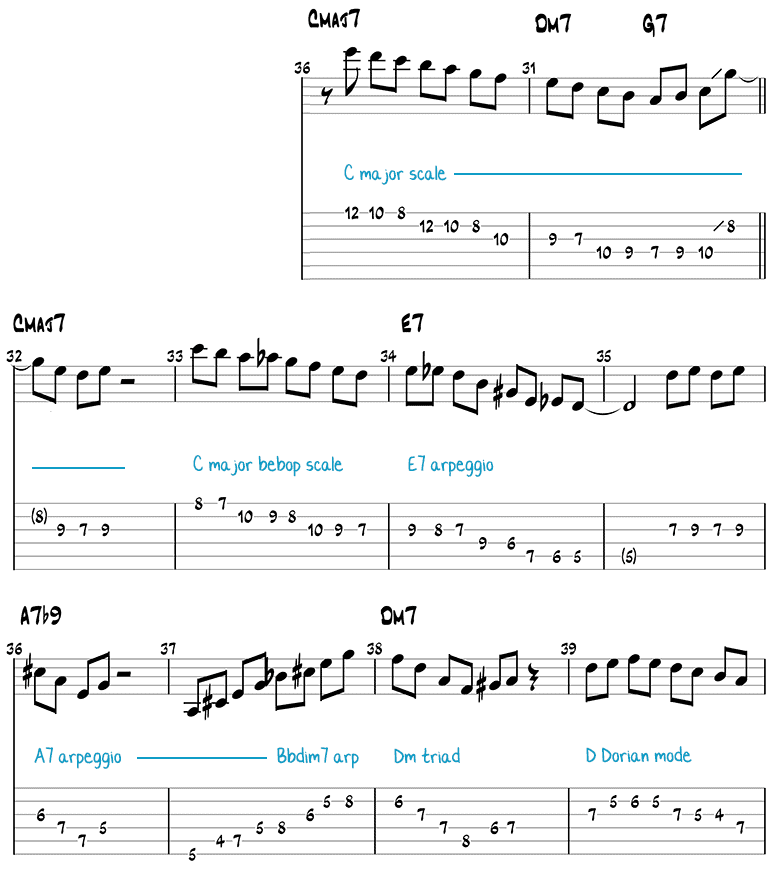
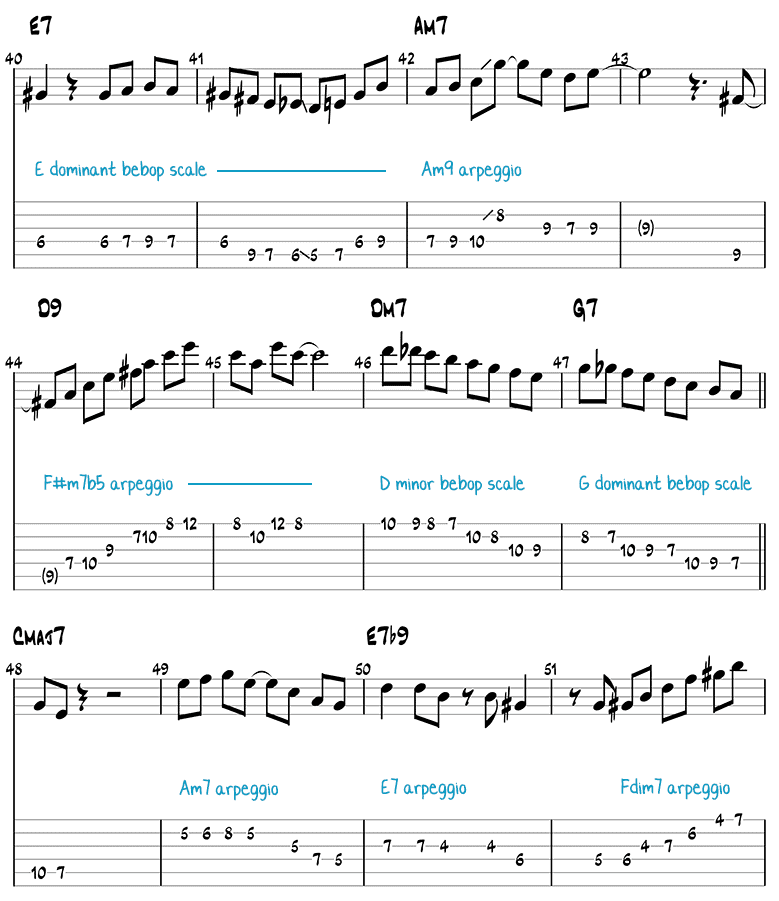
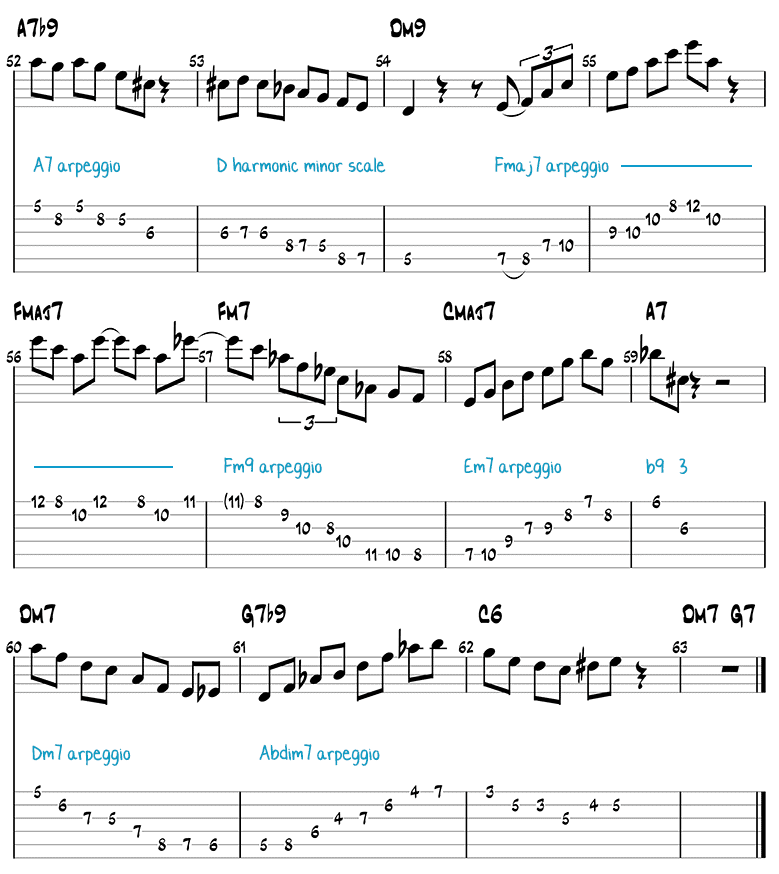

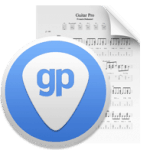
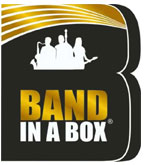
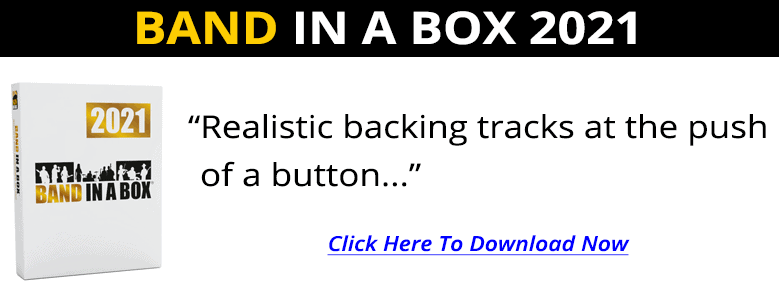

It took time but I got this solo down. Thank you so much Dirk for this rob! Canada!
Thankyou for this .I told myself that I would learn this type of soloing and I did .It reminds me of George Benson and Joe Pass . Thankyou again for this Dirk ,rob ! Canada !!
Hi Dirk, should the D7 on measure 28 in the LEAD SHEET in fact be a Dm7? That would bring it in synch with the harmonic analysis and the solo.
Great materials!
Hi Dave, I messed up the bar numbering, it’s fixed now.
Beautiful lesson Dirk, thank you.
Can you tell me the model guitar you are using.
Can I use BIAB on my iPad?
I got the pdf , it was already there! I missed it, great! many thanks for your sharing
Beautiful lesson , I play it usally with alto flute but not with such sophisticated improvvisation. The analysis is great, it encorages to step into this world
Would it possible to have a pdf score format to play with alto flute (I transpose, or musescore)?
Best regards and thanks
G.M. Federici, Milan, Italy
Thank you so very much Dirk!
You teach us so many useful things with your lessons.
I play pedal steel gtr…and I’m going to try learning this tune and your variations.
I love your improvisation!
THANK YOU!!!!
Great lesson and verey nice playing Dirk.
I downloaded the guitar pro file but my
guitar pro5 can’t open the file. Any solution?thanx
Great solo I will learn this one!
i have the solo down and now to play it behind the backing track for phrasing . Reminds me of a joe pass solol !!
Thank you very much for your time and effort. As self-taught beginner guitarist that interested in jazz, I found your content is very very useful. Thanks again.
Thank you so much for making all that wonderful material available. I’m looking forward to learning “All of Me”. Cheers, Ray (Australia)
Nice work
Thanks a lot Dirk! Awesome lessons! Such generosity! What academic talent! Clear, concise, didactic. I am a really newbie in Jazz Guitar (guess in whole guitar lenguaje! 😀 ) and your material is invaluable for me. Thanks again! Cheers from Argentina!
Dirk …your tuition material is probably the best one can get . I really appreciate it and think many others to . Keep up your hard and very good work .
I love this tune and look forward to working through the lessons. Thank you.
Am playing for many years. Best lesson and analysis I have ever found on internet. Amazing amount of work put here for our pure pleasure ! Thanks a lot.
Hi Marc, thanks for the kind feedback!
Dear Dirk, Thankyou very much for all the incredible work and playing that goes into your lessons and books. I greatly appreciate it.
Hola Dirk, justo lo que necesitaba , primera vez que encuentro una pagina que explica todo tan claro y sin ocultar informacion, exelente trabajo
muchas gracias !!!
Hi, thanks for you’re inspiring work. I’m struggling with guitar pro: because you just wrote the chord names in the sheet, I now want to enrich it with the diagrams. Works for maj7 and 7. But GP suggested strange things for m11 (1,m3,5,7,9,11 instead of 1,b3,5, b7,11) and nothing for 7b9. How to resolve this? It would be soooooo useful if you also show the chord diagrams on the homepage and also in GP (for a beginner like me)!!!!
Best Regards
Tim
Curious about your vibrato. I am a cellist learning guitar and my natural instinct is to do vibrato by rocking my finger back and forth (as on a cello) instead of the string bending type of vibrato I see in many of the guitar tutorials. Yours seems to be more of the finger rocking style. Am I seeing that right? Do you have a video explaining your approach to vibrato?
David,
I am a violinist and a guitarist. Because the guitar is fretted the vibrato is almost inaudible and the note sounds almost exact. The undulation in notes on fretless instruments is to imply “tune” to the listener. I would not worry about using a vibrato unless you want to create that sound which is done at bar if your rig has one.
Keep playing!!!
The back-and-fourth finger vibrato works better on guitars with with high frets. It works will on my Gibson Les Paul Studio with the jumbo frets, not so much on a telecaster. Place finger in center and rock towards the fret. Not as dramatic as on a cello but noticeable.
Thank you Dirk,
Been playing for 45 years and your lessons have explained more theory and musical concepts to me than any other endeavor . As others have stated , your technical abilities on this site are phenomenal .
Thank you for your excellent analysis. As an ear player, this is going to make a lengthy but enjoyable study for me.
Cómo siempre interpretación fabulosa.
Felicitaciones maestro. DIRK feliz navidad y prospero año 2022
Cómo siempre interpretación fabulosa.
Felicitaciones maestro. DIRK feliz navidad y prospero año 2022
Merry Christmas everybody
Well Done for the amazing work done here!
Thank you
Thanks Dirk!
How did u know this is my favorite song and today is my birthday… Best possible gift for me.
Thanks for u share and care wish u Merry Christmas and Happy New Year… jazz on!!!!
That was a great read! Thanks!
Thanks Dirk,
This will give me something to chew over over the Christmas. Wishing you and yours a non-Covid-affected 2022.
Alph Duggan
This is wonderful! Always appreciated! Thanks so much, Merry Christmas!
PS-I learned “Stompin at the Savoy” from your lesson.
Dirk, you are a master.
In fact I’ve bought your material. And it’s brilliant.
As a relatively new(er) jazz guitarist (but familiar with scales) I have a hard time knowing where is the right place to start with your collection.
Dirk, Thank you for all you do for all of us. I hope you have a fantastic Christmas.
I love this lesson and bought the jazz patterns and phrases course which is amazing.
Best wishes
Patrick.
thank you very useful
Merci Dirk pour le partage de ces précieuses informations à la fois mélodiques et harmoniques sur ce grand standard.👍🎶🎸
This is exactly what I needed to learn…The scales that fit the chords in tight cohesive phrases. Your organized, detailed harmonic analysis has helped tremendously to fill in the gaps in my limited knowledge of the fretboard. Great for the visual learners..Infinite thanks.
Hello, im beggining with gypsy, can you explain a bit why over the IVm “Fm” whould be a good choice to pick the melodic minor instead of the C minor scale? is it because personal taste or it is related to the estability of the IV grade to look at it as a tonal center? Because in the last option, F melodic minor, it will turn the C in the Mixolidyan b6 mode, as far as i can understand. thank you so much in advance it is a great post, machts gut!
Dirk, I searched and watched many YouTube jazz learning videos. I have watched a few of your work. They are the most useful learning tool for me at my stage of learning. It helps me to understand the reasons behind all the mystery of jazz music. Now I can at lease started to play and feel better for myself having understanding it. I like the way you analyzed every phrases. I sincerely hoping that you will do more songs. I am willing to enroll to your courses like this if they are available.
Very good explanation! The first chord of the song is a C69 Chord. In the melody there is the octave. It doesn’t sound good if you have a b9. That is the mistake which is often made in the Realbook. I prefer also an F#07 instead of an Fm chord but that is a question of taste.
Surely D harmonic minor over A7 in the C section can’t make sense. The melody has a B natural, perhaps mixolydian flat 6 would work better?
Hi Nic, D harmonic minor (=A Phrygian dominant) is a common scale to play over V/ii. You don’t have to stick to the melody when improvising…
Nic and Dirk, Generally speaking, there are several ways to play over A7 (VI7 in C) going to iim7 or II7. Normally, one would use A7b9 when resolving to a D minor chord to accent the minor flavour. Jazz offers a lot of freedom, giving the possibility to create your own voice. But. When playing in a band I think everybody should stick to the lead sheet, otherwise it won’t sound nice, resulting in dissonance and chaos. So if there’s a A7b9 written above the music, use D harmonic minor, if A7 or A9, as in section C, the best choice there is A myxolydian with b6 (or even with 6). Measure 27 of the song melody mentions clearly A9, the solo indicates in the corresponding measure 59 A7 but plays A7b9 which is ambiguous. Personally I would discuss the chords for the solo with the band, before the performance, and write there A7b9 for clarity to avoid that someone else a 9. Cheers.
Dirk,
Great tutorial with All of Me as it demonstrates the relationship between the use of different modes, scales and arpeggios used in the solo to the underlying chord changes. It’s all starting to make sense to me now.
Best,
Howard
Brilliantly explained.
Someone told me that ‘All of Me’ was a good place to see the ‘Circle of Fifths’ used.
I was baffled because the 7th chords weren’t actually in the key of C.
So ‘Secondary Dominants’!
Which I had heard of, but this was the first explanation of how they are used and their relationship to the key of the song.
Plus, you showed the scales to use for each chord.
The Analysis of the tune is an astonishingly informative infographic.
I’m not just blowing smoke, I have taught classes on using graphics to explain technical information. This page is perhaps the best I have ever seen on the Internet.
Dirk, Boa tarde.
Obrigado mais uma vez. Suas aulas são excelentes.
Sinto-me como estivesse em uma aula presencial.
Obrigado mais uma vez.
Wellington Farias
Dirk, you provide so many good ideas to build upon in this song, All of Me. I’m going to study this one and get it embedded in my brain. Thank you.
Thanks a lot! Very useful and pedagogic. Any tips for how you create etudes in Guitarpro? Just got it and cannot find any good tutorials on how to setup jazz standards and write solos like you have done.
Hallo Dirk,
Dank u voor deze prachtige les.
Maar waar zou ik ergens de bass lines kunnen vinden ?
Dank bij voorbaat,
Johan
How can i import the guitar pro file in guitar pro? Just bought that app but the files dont seem to be compatible.
Hi Vincent, you just need to double-click the file to open it.
Vielen, vielen Dank dafür, dass du diese Dinge zugänglich machst! Ich (Bass) spiele manchmal mit meinem Bruder zusammen, der als klassischer Geiger notierte Soli braucht 🙂
Hallo Sebastian, sag deinem Bruder, er soll improvisieren, es macht mehr Spaß!
man can you !!!!
Parabéns. Com essa didática, não tem como não aprender. Parabéns. Ensino perfeito. Não tenho palavras para agradecê-lo. Que maravilha de ensino.
Very interesting with professional content. Thanks and congratulations for what you do and participate in others.
You’re welcome, Francesco, thanks for the kind feedback!
Thank you for this, a tune I have always liked and the lesson was well good to follow.
Thanks enjoying learning this
thank , grazie . ciao from Italy .
Great work! Very good show of simplicity of complexity! Nice sound and good phrasing in solo.
Thanks Igor!
Very nice. Great interpretation of this standard. Thanks so much for posting this.
Thank you so much, Maestro. Your work really builds musical culture and spreads knowledge. This deserves admiration and gratefulness from everybody.
Really enjoying this, thank you. its a lot of fun to play.
Great, very inspirational for a beginner!
Maravillosa lección. Muchas gracias maestro.
precioso tema.
muy bien escogido para que tambien podamos practicar los que no tenemos un grado avanzado en ‘jazz-guitar’
me anima a persistir en el camino de aprender
Excellent interpretation, congratulations teacher!
Awesome
Lessons are super
This is a great collection of elements to make a really helpful lesson. Thank you!